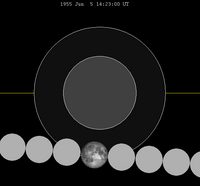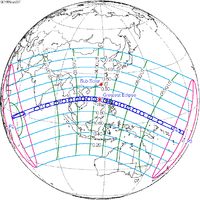| Penumbral eclipse | |||||||||
 The Moon's hourly motion shown right to left The Moon's hourly motion shown right to left | |||||||||
| Date | June 5, 1955 | ||||||||
|---|---|---|---|---|---|---|---|---|---|
| Gamma | −1.2384 | ||||||||
| Magnitude | −0.4498 | ||||||||
| Saros cycle | 110 (68 of 72) | ||||||||
| Penumbral | 232 minutes, 18 seconds | ||||||||
| |||||||||
| ← January 1955November 1955 → | |||||||||
A penumbral lunar eclipse occurred at the Moon’s ascending node of orbit on Sunday, June 5, 1955, with an umbral magnitude of −0.4498. A lunar eclipse occurs when the Moon moves into the Earth's shadow, causing the Moon to be darkened. A penumbral lunar eclipse occurs when part or all of the Moon's near side passes into the Earth's penumbra. Unlike a solar eclipse, which can only be viewed from a relatively small area of the world, a lunar eclipse may be viewed from anywhere on the night side of Earth. Occurring only about 11 hours after apogee (on June 5, 1955, at 3:45 UTC), the Moon's apparent diameter was smaller.
Visibility
The eclipse was completely visible over east, Australia, and Antarctica, seen rising over the western half of Asia and east Africa and setting over the eastern Pacific Ocean.
 
|
Eclipse details
Shown below is a table displaying details about this particular solar eclipse. It describes various parameters pertaining to this eclipse.
| Parameter | Value |
|---|---|
| Penumbral Magnitude | 0.62181 |
| Umbral Magnitude | −0.44978 |
| Gamma | −1.23842 |
| Sun Right Ascension | 04h51m12.9s |
| Sun Declination | +22°30'11.9" |
| Sun Semi-Diameter | 15'45.8" |
| Sun Equatorial Horizontal Parallax | 08.7" |
| Moon Right Ascension | 16h51m07.1s |
| Moon Declination | -23°37'02.2" |
| Moon Semi-Diameter | 14'42.6" |
| Moon Equatorial Horizontal Parallax | 0°53'59.1" |
| ΔT | 31.2 s |
Eclipse season
See also: Eclipse cycleThis eclipse is part of an eclipse season, a period, roughly every six months, when eclipses occur. Only two (or occasionally three) eclipse seasons occur each year, and each season lasts about 35 days and repeats just short of six months (173 days) later; thus two full eclipse seasons always occur each year. Either two or three eclipses happen each eclipse season. In the sequence below, each eclipse is separated by a fortnight.
| June 5 Ascending node (full moon) |
June 20 Descending node (new moon) |
|---|---|
 |

|
| Penumbral lunar eclipse Lunar Saros 110 |
Total solar eclipse Solar Saros 136 |
Related eclipses
Eclipses in 1955
- A penumbral lunar eclipse on January 8.
- A penumbral lunar eclipse on June 5.
- A total solar eclipse on June 20.
- A partial lunar eclipse on November 29.
- An annular solar eclipse on December 14.
Metonic
- Preceded by: Lunar eclipse of August 17, 1951
- Followed by: Lunar eclipse of March 24, 1959
Tzolkinex
- Preceded by: Lunar eclipse of April 23, 1948
- Followed by: Lunar eclipse of July 17, 1962
Half-Saros
- Preceded by: Solar eclipse of May 30, 1946
- Followed by: Solar eclipse of June 10, 1964
Tritos
- Preceded by: Lunar eclipse of July 6, 1944
- Followed by: Lunar eclipse of May 4, 1966
Lunar Saros 110
- Preceded by: Lunar eclipse of May 25, 1937
- Followed by: Lunar eclipse of June 15, 1973
Inex
- Preceded by: Lunar eclipse of June 25, 1926
- Followed by: Lunar eclipse of May 15, 1984
Triad
- Preceded by: Lunar eclipse of August 3, 1868
- Followed by: Lunar eclipse of April 5, 2042
Lunar eclipses of 1955–1958
This eclipse is a member of a semester series. An eclipse in a semester series of lunar eclipses repeats approximately every 177 days and 4 hours (a semester) at alternating nodes of the Moon's orbit.
The penumbral lunar eclipse on January 8, 1955 occurs in the previous lunar year eclipse set, and the penumbral lunar eclipse on April 4, 1958 occurs in the next lunar year eclipse set.
| Lunar eclipse series sets from 1955 to 1958 | ||||||||
|---|---|---|---|---|---|---|---|---|
| Ascending node | Descending node | |||||||
| Saros | Date Viewing |
Type Chart |
Gamma | Saros | Date Viewing |
Type Chart |
Gamma | |
| 110 | 1955 Jun 05
|
Penumbral
|
−1.2384 | 115 | 1955 Nov 29
|
Partial
|
0.9551 | |
| 120 | 1956 May 24
|
Partial
|
−0.4726 | 125 | 1956 Nov 18
|
Total
|
0.2917 | |
| 130 | 1957 May 13
|
Total
|
0.3046 | 135 | 1957 Nov 07
|
Total
|
−0.4332 | |
| 140 | 1958 May 03
|
Partial
|
1.0188 | 145 | 1958 Oct 27
|
Penumbral
|
−1.1571 | |
Saros 110
This eclipse is a part of Saros series 110, repeating every 18 years, 11 days, and containing 72 events. The series started with a penumbral lunar eclipse on May 28, 747 AD. It contains partial eclipses from August 23, 891 AD through April 18, 1288; total eclipses from April 29, 1306 through September 5, 1522; and a second set of partial eclipses from September 16, 1540 through April 22, 1883. The series ends at member 72 as a penumbral eclipse on July 18, 2027.
The longest duration of totality was produced by member 38 at 103 minutes, 8 seconds on July 3, 1414. All eclipses in this series occur at the Moon’s ascending node of orbit.
| Greatest | First | |||
|---|---|---|---|---|
| The greatest eclipse of the series occurred on 1414 Jul 03, lasting 103 minutes, 8 seconds. | Penumbral | Partial | Total | Central |
| 747 May 28 |
891 Aug 23 |
1306 Apr 29 |
1360 May 31 | |
| Last | ||||
| Central | Total | Partial | Penumbral | |
| 1468 Aug 04 |
1522 Sep 05 |
1883 Apr 22 |
2027 Jul 18
| |
Eclipses are tabulated in three columns; every third eclipse in the same column is one exeligmos apart, so they all cast shadows over approximately the same parts of the Earth.
| Series members 60–72 occur between 1801 and 2027: | |||||
|---|---|---|---|---|---|
| 60 | 61 | 62 | |||
| 1811 Mar 10 | 1829 Mar 20 | 1847 Mar 31 | |||
| 63 | 64 | 65 | |||
| 1865 Apr 11 | 1883 Apr 22 | 1901 May 03 | |||

|

| ||||
| 66 | 67 | 68 | |||
| 1919 May 15 | 1937 May 25 | 1955 Jun 05 | |||

|

|

|

|

|

|
| 69 | 70 | 71 | |||
| 1973 Jun 15 | 1991 Jun 27 | 2009 Jul 07 | |||

|

|

|

|

|

|
| 72 | |||||
| 2027 Jul 18 | |||||

|

| ||||
Half-Saros cycle
A lunar eclipse will be preceded and followed by solar eclipses by 9 years and 5.5 days (a half saros). This lunar eclipse is related to two partial solar eclipses of Solar Saros 117.
| May 30, 1946 | June 10, 1964 |
|---|---|

|

|
See also
Notes
- "June 5–6, 1955 Penumbral Lunar Eclipse". timeanddate. Retrieved 23 December 2024.
- "Moon Distances for London, United Kingdom, England". timeanddate. Retrieved 23 December 2024.
- "Penumbral Lunar Eclipse of 1955 Jun 05" (PDF). NASA. Retrieved 23 December 2024.
- "Penumbral Lunar Eclipse of 1955 Jun 05". EclipseWise.com. Retrieved 23 December 2024.
- van Gent, R.H. "Solar- and Lunar-Eclipse Predictions from Antiquity to the Present". A Catalogue of Eclipse Cycles. Utrecht University. Retrieved 6 October 2018.
- "NASA - Catalog of Lunar Eclipses of Saros 110". eclipse.gsfc.nasa.gov.
- Listing of Eclipses of series 110
- Mathematical Astronomy Morsels, Jean Meeus, p.110, Chapter 18, The half-saros
External links
- 1955 Jun 05 chart Eclipse Predictions by Fred Espenak, NASA/GSFC
This lunar eclipse-related article is a stub. You can help Misplaced Pages by expanding it. |


